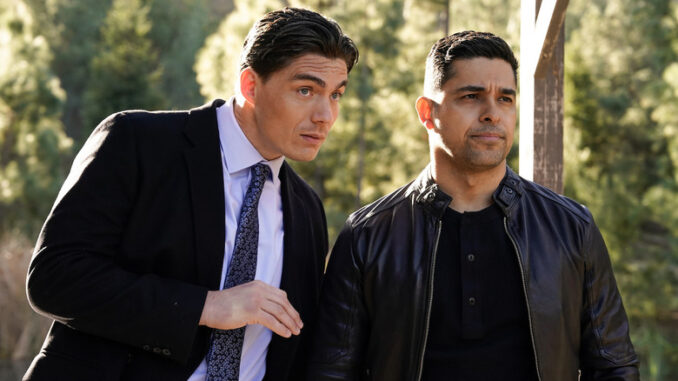
When NCIS announced its long-awaited crossover with NCIS: Origins, fans expected Mark Harmon’s presence, emotional callbacks, and maybe a few clever nods to Gibbs’ early years. What no one saw coming was that two of the most unexpected figures from Origins—forensic analyst Woody and chemist Phil—would become the emotional core of the event.
And now, thanks to exclusive photos and insider commentary, it’s official: Bobby Moynihan and Ely Henry are reprising their roles—this time, as older versions of their younger Origins selves, appearing in NCIS Season 23, Episode 5, titled “Now and Then.”
This crossover doesn’t just bridge two timelines—it redefines what legacy means in a universe that has spanned over two decades of television.
⚓ The Case That Spans 30 Years
The two-part crossover begins not on NCIS, but on Origins, where a seemingly contained murder—the death of a naval officer in a small coastal town—sets off a chain of events that won’t end for another three decades.
When the case resurfaces in present-day NCIS following a prison break, Torres (Wilmer Valderrama) and Parker’s team must reopen the long-dormant file. And who holds the key to the mystery? None other than the now-aged Woody and Phil—two men whose friendship, and brilliance, have somehow survived both time and trauma.
“They’re going to have a piece of evidence that’s pivotal to the case,” executive producer Steven D. Binder reveals. “They’re hysterical… they were just off in their own world while shooting. You can’t script that kind of chemistry.”

🧬 Why Woody and Phil? The Logic Behind the Leap
The NCIS universe has never been afraid of a little temporal gymnastics. But this crossover’s decision to bring back Woody (Moynihan) and Phil (Henry) instead of more obvious choices—like Gibbs or Franks—was a deliberate, even poetic move.
According to Origins showrunners David J. North and Gina Lucita Monreal, the creative reasoning was both strategic and sentimental.
“We adore them,” North says. “And we also wanted to keep our cards close to the vest with some characters. There are certain people we don’t want to reveal as alive or dead yet. But you can break the news here: Woody and Phil survive, no matter how long Origins runs.”
In other words: not only do these two make it out alive—they outlast decades of danger in the NCIS timeline.
That revelation might seem small, but in the high-stakes, death-filled world of NCIS, it’s practically a miracle.
💥 The Stakes of Survival
For Binder, there’s a fascinating creative tension in confirming any Origins character’s long-term survival.
“Here’s the danger in doing an episode like this,” he explains. “These are cop shows—people die all the time. We lost Jenny Shepard, Mike Franks, Ziva’s father, Vance’s wife… The stakes are real. But when you show someone alive 30 years later, you take away that danger. They become, in a sense, untouchable.”
That’s why choosing Woody and Phil mattered. They’re not combat heroes or hardened agents. They’re the oddballs—the human pulse of a sometimes procedural machine. Giving them longevity doesn’t weaken tension; it reinforces hope.
“They’re two peas in a pod,” Binder adds. “They’re the comic relief, the grounding force, and the last people you’d expect to carry the emotional heart of a crossover like this. And that’s exactly why it works.”
🔍 When Humor Becomes Legacy
In both NCIS and Origins, science has always been a kind of sacred language—one spoken by the eccentric geniuses who help the agents see what others miss. Moynihan and Henry embody that legacy perfectly.
In Origins, their younger versions brought levity to Gibbs’ early days—a mix of awkward genius and wide-eyed wonder. Seeing them aged and weathered, now veterans in their own right, transforms their once-comedic energy into something quietly profound.
Time, in this universe, isn’t just a narrative device—it’s a test of endurance.
⚖️ When Timelines Collide
The crossover also features a creative shake-up: for one night only, Origins and NCIS will swap timeslots, ensuring fans experience the story in chronological order. It’s a rare structural experiment for the franchise—and one that underscores how deeply the two shows are connected.
It’s also a symbolic gesture. Origins has always been about the beginning of the myth; NCIS represents its continuation. Together, they tell one seamless story of how ideals survive even as faces change.
🕰️ The Legacy of Laughter and Loyalty
At its core, “Now and Then” isn’t just a procedural crossover—it’s a reflection on what survives when the dust of decades settles.
Woody and Phil’s reappearance doesn’t just delight fans; it reaffirms a simple truth that NCIS has whispered for 23 seasons: heroes aren’t always soldiers. Sometimes, they’re the scientists in the lab—the ones who laugh, stumble, and stay.
In a franchise built on justice, this crossover offers something rarer: continuity of heart.
